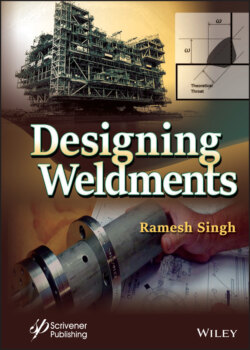Читать книгу Designing Weldments - Группа авторов - Страница 21
2.1.3.1 Modulus of Elasticity
ОглавлениеThe ability of a metal to resist stretching (stain) under the stress is defined by the ratio of the two. This is called the Modulus of Elasticity and indicated by letter E. This is a constant value for specific metal. The Table 2.2 below gives Modulus of Elasticity values of some of the common engineering metals.
where;
Table 2.2 Modulus of elasticity of common engineering metals.
| Metal | Modulus of elasticity, psi |
| Aluminum | 9.0 × 106 |
| Beryllium | 42.0 |
| Columbium | 15.0 |
| Copper | 16.0 |
| Iron | 28.5 |
| Lead | 2.0 |
| Molybdenum | 46.0 |
| Nickel | 30.0 |
| Steel, (Carbon and alloy steels) | 29.0 |
| Tantalum | 27.0 |
| Titanium | 16.8 |
| Tungsten | 59.0 |
The elastic modulus is a structure sensitive property, (see Table 2.1) is not changed by metal’s gain size, cleanliness, by significant alloying, or by heat treatment. However, modulus of elasticity decreases with increasing temperatures, and the rate of change is not same for all metals.
The modulus indicates that, how much a beam would deflect elastically under the load, or a bar would elastically stretch, when loaded. In welding engineering the modulus is frequently used to determine the level of stress created in a piece of metal when it is forced to stretch elastically for a specific amount. In this case the stress (σ) can be determined by multiplying the strain (ϵ) by the modulus of elasticity (E) which is a constant for the given metal.
